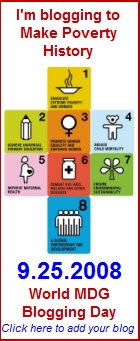Urged On
Here is sermon number one for the week - preached in Seabury Chapel, on the (transferred) feast of Mary Magdalene.
Did you know that instant messaging can be a spiritual discipline? Well, alright. Maybe not a discipline all by it self – but it can help. My friend Heather and I have a kind of private cheering squad going on our IM chats. When I’m having a hard time with a paper, or she is having a rough day at work, we’ll check in online. And for me, one of the reasons I check in with her is because I know that when I say “okay, I really gotta work on this stuff” I’ll get a message all in capital letters that says “GO SUSIE GO” followed up by another one saying “YOU CAN DO IT! GO SUSIE!” I like to think of myself as the kind of person who gets things done – but I’m really the kind of person who thrives on encouragement.
This is why Mary Magdalene –especially in today’s Gospel is so curious and inspiring to me. She seems to be a woman of action: a confident woman who gets things done, even if she tends to be on the stubborn side. She might be the kind of woman that some of us would call ‘assertive” while others might say… well, you get the point. She is up and at the tomb before dark, and she doesn’t seem to need a cheering squad at all. Mary Magdalene exemplifies what Paul wrote to the Corinthians: She is a woman of action because she is urged on by the love of Christ.
The love of Christ urged Mary on in the early hours of a Sunday morning, to find the tomb where her friend Jesus was laid. This would not have been a particularly safe excursion, for a woman to go out by herself before dawn – especially not to visit the grave of a man executed for treason and blasphemy. Yet, her love for Jesus outweighed her fear, and she was moved to action.
Even when the tomb is empty, she is not deterred from action. Her love of Christ moves her to action as soon as someone appears who might have some answers to her questions. Sure, she is confused and mistakes Jesus for the gardener – but since when did following Jesus with our whole heart mean we wouldn’t make mistakes? Even through her confusion, her commitment to action and the urgings of her love lead her to see the risen Lord. Then, her love of Christ moves her beyond the garden. She is sent to share the good news. Mary Magdalene becomes the first witness to the Resurrection, and earns the title “Apostle to the Apostles” for her action, her willingness to go, to proclaim. This woman of action is a wonderful role model for all us 21st century mission-minded folk: no maintenance mentality here!
But with all this doing, we might easily miss the most important action of all: Urged on by her love of Christ, Mary Magdalene waits and weeps. Mary is both unable to leave and strengthened to stay because her love for Jesus was so compelling and so strong. Call it perseverance, or patience or loyalty – the pull on her heart that kept her there can only be produced by profound love. The love of Christ is a powerful thing – it brought Mary Magdalene to do the unexpected, to witness the glorious and surprising Resurrection on the first Easter morning.
If the love of Christ could urge on Mary Magdalene – who didn’t have the advantage of already knowing the end of the story in the garden – how much more powerfully might we be urged on by our own love of Christ? We are surrounded by stories of people moved by the love of Christ. We uproot our lives and our families to come here, in order to follow a call to ministry as students and teachers. The love of Christ moves a congregation to feed the hungry despite the neighbors complaints, leads others to serve people they have never met in a country devastated by war.
But more importantly, the love of Christ urges us on beyond who we are to who we might be. It makes the impatient and action-oriented sit still in a garden long enough to see the Risen Lord. It keeps us moving forward towards a new understanding of life, death and ministry even when we’d really rather stay with what we know. The love of Christ urges us on to see Jesus alive and active in the world, and then urges us on beyond the encounter – however much we would like to hold on- so that we can bring others into the knowledge of God. It keeps the beat in this ongoing dance of action and inaction, of seeking and sending, of doing and being. The love of Christ urges us on, and keeps us looking for the next surprise, the next action to take, the next time we will be able to claim with joy and love: I have seen the Lord, and Christ is risen!
